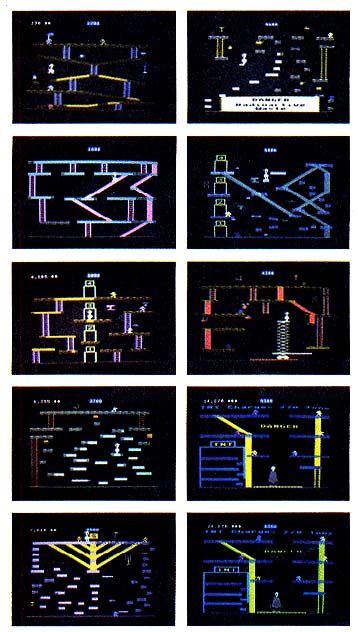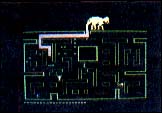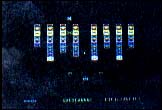Reviews
Miner 2049er
by Bill Hogue
Big Five Software
Van Nuys, CA
16K Cartridge
400/800/1200
$49.95
by Pat Henderson
Beware all of you arcaders out there in Videoburg! We have a new foe to conquer, and it must be treated with the utmost of caution. This new arcade wonder surpasses the powers of Pac-Man, and ascends to greater heights than Donkey Kong.
Miner 2049er is the brash new adversary, the latest offering from the indisputable computer arcade champion, Big Five. Bill Hogue, the master mind behind many machine language games for the TRS-80 (Galaxy Invasion Plus, Cosmic Fighter), remains at the top of his form in his first venture into the Atari market.
Hogue may have borrowed the monster-munching spirit of Pac-Man, the girder-climbing aspect of Donkey Kong, and the claustrophobic underground of Dig Dug, but he's hashed them up, added many new dimensions and created the perfect arcade game.
Imagine, you're "Bounty Bob" trapped deep underground in a futuristic mining shaft. You have to scramble to the surface while dancing over floors of striated girders, turning them into solid structures. The Mutants that guard the shaft are right behind you, so close you can feel their radiation singeing your Levi's. When all seems hopeless, a shovel appears. You grab it, and chase the Mutants to their doom. When you finally crawl your last few steps to the top, completing all the girders, you find yourself transported to another level of the mine shaft. Everywhere you go in Miner 2049er you're surrounded by strangers in even stranger surroundings.

|
| Reading from the top down, column one shows screen levels 1-5, while column two shows screens 6-10. Photos by Paul Grupp |
Bounty Bob tries to make his way from the bottom level of the mine shaft to the uppermost level, accumulating the highest score possible, with only four short-lived lives. Each level of the mine is divided up into many floors of girders which you must try ever so desperately to transform from stripes into a solid platform. You can get to most of these platforms by running up and down a ladder or taking a slide. Still others seem to free-float and you must leap toward them and hope that you make it.
As you navigate the girders, you must evade one or more patrolling Mutants that guard each floor. These Mutants are radioactive and, when touched, turn Bounty into a sizzling puddle of miner de jour. You can hurdle the Mutants, or if you grab one of the various weapons available in each level, you can destroy them.
The weapons vary in each level of the mine, but they're the usual array of mining paraphernalia: hammers, picks, canteens, goggles, martinis, flowers, and Atari joysticks (martinis, flowers, and Atari joysticks?????). When you grab a weapon, the Mutants turn green with fright, and you can run over them. Caution! After five to ten seconds they soon regain their bravery and turn back to their original state of nastiness. This reminds me of the Power Pills in PacMan.
After you have transformed all girders from stripes to solids, you progress to the next level of the mine. Beware! As you advance, the nastiness of the Mutants increases and their cowardice decreases. As levels of play increase, the game delivers some new elements. For instance, Level 2 has many slides that can catch you as you run over them and send you plummeting, frightfully but safely, to the bottom of the screen. If you're agile enough, you can jump these slides to ensure your safe passage.
To make the game even more frustrating, you have only a certain amount of time to complete each level. The time varies for each screen. The timer starts at a number like 3500 or 4500 and counts down by increments of 100. When you finish a level, the time remaining is added to your score as a bonus.
If you're like me, in your first experience with "Bounty Bob" you'll probably play for points. You can rack up a fairly high score, even if you haven't been playing the game for long. The scoring is simple. Each transformation of a girder section is worth five points; the Mutants are worth either 80 or 90 points. The maximum points are obtained by grabbing a weapon for Mutant destruction. Weapons are worth from 100 to 500 by factors of one hundred. If you are going to play for points, go for the weapons and Mutants first.
After a while, you'll want to see what each level of the mine shaft looks like. If you play the game cautiously enough and avoid going for foolish unnecessary points, you can advance to the next game level. I have played a game or two where I exhausted all my men on the third level, but I earned over 20,000 points. However, a time or two I have glimpsed Levels 5 and 6 and only accumulated a score of 15,000 to 18,000. So Bounty can be either an adventurer or a greedy point grabber.
As you learn to skate from girder to girder gracefully, and master Mutant annihilation, you'll need a strategy for each level of play. Each level is different from the preceding, and each has its own distinct personality. If you're going to venture into these suicidal caverns, here are some basic playing tips for Levels 1-5.
Level 1: Do anything your instincts tell you to. This is an introductory level.
Level 2: Complete the floors from left to right, and bottom to top. BEWARE of slides! To jump a slide hurl yourself over the "mouth" of the slide. Also, you must slip down the upper most slide to complete this screen.
Level 3: Complete the left side of the screen first, the top second, then the right side, saving the transporter floors for last. Enter Transporter I first, go to Transporter 3, then down to Transporter 2. This is the easiest level so far.
Level 4: Climb the tall ladder first and complete this floor clockwise. Don't waste time! Objects hang around this screen in the most strategic places. This is definitely the hardest level up to this point.
Level 5: The only hint I can give is, miners don't like martinis. This level is a killer!
Miner 2049er is a must for any arcader's collection. It has the makings of a classic. If all goes well for Big Five we might even see Bounty Bob lunch boxes, Bounty Bob pillows, and even Bounty Bob cartoons on Saturday morning. Good-bye Pac-Man, step aside Donkey Kong, here comes Miner 2049er!
Pat Henderson is a regular contributor to the Hi-Res review pages.

|
| Bill Hogue, a programmer turned businessman who began his career on the TRS-80 and has successfully made the transition to the booming Atari market. |
Bill Hogue started programming on a TRS-80 in 1979, while he still worked for Radio Shack. He still has a beef with them about the computer he bought. "I wasn't allowed to write-up my own sale."
All employees received a ten percent discount on their purchases, but Hogue explained that another salesman had to write your ticket for you. That meant that the other guy took home the commission on the sale.
if Bill couldn't get the commission on the sale, then he didn't want anyone to get it. When he tried writing up his own purchase order, the ticket was nixed by management.
He bought the system anyway and the young programmer/founder of Big Five has never regretted it.
Though he hasn't forsaken his 80, Bill created his latest arcade attraction, Miner 2049er, for the Atari. And more programs are to follow. Already in development is something called Scraper Caper, the further adventures of "Bounty Bob."
Bounty Bob, the 49er of arcade fame will break new ground when Miner 2049er is introduced on a cartridge for the Atari 5200. To Hogue's knowledge, Miner will be the first such 400/800 ROM cartridge translated to the 5200.
"The cartridges (for the 5200 and the 800) are programmed differently," said Hogue, "but we were aware of these differences when we programmed Miner."
Bill has come a long way since he dropped his first half-page ad in 80 Micro for Super Nova. Watch for more from Big Five.
K-razy Antiks
K-razy Kritters
By K-Byte Software
CBS Software
Cartridge
Atari 400/800/1200
Price: N/A (Coming down according to CBS)
Run for the hills, everyone! The Antiks are coming! Or so you'd think, when you play K-razy Antiks from CBS Software. K-razy Antiks, a cartridge-based program, transforms you into a white ant among six anthills.
The object of the game is for you to maneuver your white ant around the twisting tunnels of the hill, while avoiding four enemy ants and the tongue of the killer anteater! As you dodge these dangers, you must avoid a soaking from the torrential rain storms that flood the anthill. To remain alive in the game, you drop white eggs around the hill. These enable you to hatch out a new self when you die. You start the game with 40 eggs, but the enemy ants eat them, if they run across one. If you die with no eggs in the hill, you disappear into ant heaven.

|
| CBS's K-razy Antics |
The enemy ants also lay eggs. By snatching one of these and dropping it in front of him, you can destroy him. These are ant traps. Another way of forcing an enemy into the trap is to lure him into the flooding rain or into the tongue of the killer anteater. After you've secured all four ants in the ant trap, you graduate to the next level of play.
The anteater is one of the software's most oral enemies. He sticks his tongue into the top of the anthill and probes the tunnel, until he has satisfied his appetite or he becomes discouraged enough to go home. The flood waters from the rain storm rise from the bottom of the hill and stop at some random point. Guaranteed safety rests in the top tunnel of the hill. Any contact with either the anteater's tongue or the flood waters spells curtains for you and the enemy ants.
K-razy Antics is designed to challenge you to increasingly difficult levels of play. Although the game doesn't emphasize point gathering you die-hard arcaders can still stack up a hefty score while enjoying the strategy aspects of this zany funfest. K-razy Antics is an original, and a solid addition to any gamer's collection.
"Star Base One to Star Base Defense. . . Kritters are now being teleported to attack position. At last count 8 stacks of 10 Kritters were poised for attack. Take care boys and watch out for the freefalling Kritters that sneak attack between each row."
That was the last transmission from Star Base One before I struck out to defend our home base against the Alien Kritters who attack in the Stack Attack formation that is so prevalent in other popular games like Space Invaders, Galaxian, and Galaga.
K-razy Kritters, like Antiks, was written by the people at K-byte Software and are receiving a well-deserved re-exposure from CBS Software who licensed the company's wares last year.
Though similar to so many other games, Kritters still manages a few surprises. For example, no other game has a cleanup crew clear your mess off the screen after you fail to eliminate all of the Alien Kritters. No other game has free-falling Kritters that sneak attack between each stack of regulars. And lastly, no other stack attack game has Supermissiles can which destroy an entire stack of kritters at one blow.

|
| CBS'S K-razy Kritters |
K-razy Kritters also challenges you with an alien kamikaze. When your ship shoots the bottom-most alien Kritter off the stack, he attacks you. You must either dodge his attack or exterminate him. Other Kritters fall between the stacks and attack you at random intervals. Destroy these or dodge their attack path. The high-and-mighty Alien Patrol Kritters appear sporadically to check up on their troops. They travel from either left to right or vice versa. For each patrol you destroy, Star Base One awards you another ship.
If your ship gets shot out from under you, Star Base One sends out the Sanitation Crew to clean up your mess, outfits you with another vessel and sends you back into battle. Lose all of your ships and you are cast out among the other losers of the Universe.
If all else fails, launch the all powerful "Supermissile" which destroys everything it hits. Star Base One only gives you one per attack wave of Kritters. If you're good enough, and don't have to resort to your Supermissiles, you can accumulate them to use on future levels.
K-razy Kritters is for the arcader who has to get a score in the tens or hundreds of thousands to feel satisfied with a game. After clearing away a wave of Kritters, you do progress to a new level of faster action, but each level is the same as the previous one except for the attack speed. If you liked Space Invaders, you'll love K-razy Kritters.
-Pat Henderson
Jumbo Jet Pilot
Submarine Commander
ROM Cartridge
400/800
Thorn EMI
New York, NY
$49.95 each
by Jim Wooding
Open the truly well-made package (looks about the same size as a Beta VCS tape box, but built strong enough to hold Tonka's elephant!), remove the instructions, turn the cover and read: "This exciting and sophisticated flight simulator offers a real insight into the arts and problems of flying." Read on, my high-flying friends.
After thoroughly reading the instructions (those six-figure salaries of wide-body jet pilots have always appealed to me), I quickly removed the 16K cartridge from its container, plugged it into my 800, fastened my seat belt and radioed the tower for clearance instructions. (Actually, it was more like instructions to the family for quiet while I took on this new "challenge"!)
Using the keyboard for viewing the landing lights and raising and lowering the undercarriage/landing gear (DON'T push "U" while you're still on the ground!!!), and the joystick for elevator and rudder controls, I began my long-awaited flight.
The screen display reveals an array of instruments and the windshield, through which I can see the runway up ahead. Believe it or not, it took over 12 minutes to reach the runway! There are two left turns to make before reaching the main runway for lift-off. Another 12 minutes of taxiing before the required speed for lift-off! All totaled, 24 minutes had elapsed--just sitting during the taxiing. (If you like chess, you'll like this program!)
Well, the jumbojet is in the air. I can see the horizon in the windshield (nice graphics during banking turns), and the stewardess comes in to tell me coffee is ready! (I'm still trying to figure out how my wife showed up with my cup at 1500 feet!)
Now for you really avid chess fans, get this. There is very little to do but wait once you get your aircraft trimmed and leveled off. Looking at the map every few minutes I soon realized that this is a "true" simulation program. (I once flew from Los Angeles to Denver in less time than this flight was going to take me!)
After 30 minutes I was barely half way to the other airport. One hour, 28 minutes and 56 seconds later (a clock is nicely displayed above the windshield) with 9/10 of my journey complete and while descending to make my landing approach . . . CRASH! My descent had been too steep and once again Sir Issac Newton's theory proved true--that whatever goes up must come down.
The only major problems with this program were: 1. Lengthy taxiing (20 minutes plus); 2. To descend, you are instructed to "reduce the throttle setting slightly, then raise the elevators a little . . " I found that even decreasing the engine speed to minimum the plane could still increase altitude by pulling the stick back.
Like Jumbo Jet Pilot, the cartridge container is made like a vault! Opening the box, and taking out the small book of instructions made me actually feel like a World War II submarine commander out at sea opening his secret mission instructions.
And, thus, the mission unfolds: "You are in command of a submarine in the Mediterranean. Your mission: to attack and destroy the enemy convoys scattered over the sea. To help you: a map, sonar, periscope and torpedoes. There's more to it than that, of course. The enemy, for one thing, can hit you with shells and depth charges, so you can also have a full instrument panel to help you creep up undetected."
How true it is! Of the enemy ships which are your goal there are destroyers, tankers, patrol boats, and cargo ships. Some don't attack unless attacked. Others (like destroyers) get enjoyment out of sitting directly over you dropping depth charges while you dive deeper and deeper, trying to escape the cans, only to discover that there is no escape.
This simulation game is truly habit-forming! The challenge is there . . . stay periscope depth ... aim... : "FIRE ONE, FIRE TWO"! From across the room comes confirmation, "Aye, aye, Captain. Torpedoes one and two away!"
Then you wait. If your aim was good, you'll see the hit and watch the enemy ship sink. In the higher levels of play (there are nine in all), it may take more than one direct hit to sink a ship. A crash dive may be in order, as often, once your torpedo has been detected, the shelling begins. Through the periscope you can see the gunblasts, and, moments later, the whine of the cans as they fly through the air and explode in the water. Take enough hits and your sub can sink. There is always plenty to do in Submarine Commander. The instrument panel consists of a compass, depth gauge, damage indicators (indicating hits taken), clock, tonnage sunk recorder, air supply, torpedo supply, fuel supply, battery charge reading, speed reading, (in knots), attitude indicators (horizontal and vertical), a clock (mission time since beginning of game).
In the center (is there room enough? YES! Graphics are excellent!) is a tri-purpose area. You have your choice through keyboard inputs to select a map of your mission area (the Mediterranean Sea), showing your position and the enemy convoys, sonar. The sonar is equipped with a hydrophone chart that reacts to the enemy ships' engines long before the sonar begins to pick them up. Your periscope has a one mile range.
Unlike some other simulation programs this one is very realistic and gives you the sensation that you are really diving; really firing torpedoes; really being fired upon with depth charges. The screen display shakes with each hit and a realistic explosive sound convinces you that your sub is under attack! Submarine Commander is fast-paced enough to keep you on your toes during each engagement.
The only complaint I've heard is the time it takes to move across the Mediterranean to catch up with a convoy (surface speed is much faster and allows for repairs, oxygen replenishment, and battery charge). My reply is, "show me another way you can cross the Mediterranean Sea in only 5 minutes!"
If there is a weakness to this fantastic game, it is only this length of time required to maneuver your submarine to one of the enemy convoys!
If under attack, you have the opportunity to crash-dive (push "C" on the keyboard) in hopes of escaping. (Watching the display in the center-right of the screen allows you to keep from crashing.) Once safe, a quick return to periscope depth can be accomplished by blowing your ballast (push "B" on the keyboard).
Speed is selectable, from standing still to nine-knots (20 knots when surfaced), and if dinner is ready and you have to leave the bridge, you can either "pause" the game or "abort" the mission altogether. A rating is given if aborted as well as if completed.
There is no question about Submarine Commander. It is the underwater Star Raiders!
Jim Wooding will be reviewing software regularly for Hi-Res. He lives in Santa Maria, California, where he is president of the Lompoc/Santa Maria Atari Users Group.
Spell Wizard
32K Disk
Dictionary Disk
Datasoft, Inc.
Chatsworth, CA
$79.95
Writers are supposed to be notorious misspellers. In my case, I can spell well, but my fingers don't always find the keys I want. Now, the good folks at Datasoft have come to the rescue with Spell Wizard. This is a spelling checker program with a dictionary of over 33,000 words. And, if that isn't enough, you have the option of preparing your own dictionary of terms.
Spell Wizard can run on a one- or two- disk drive system. The software is easy to use in either configuration. Datasoft provides a program disk and the dictionary disk. The user dictionary is stored on a third diskette that you provide.
Place the program disk into drive 1, turn the computer on and a menu appears on the screen. Using the Option key, you can choose whether to Proof a Document, Print Dictionary, Search Dictionary, or to Exit Spell Wizard. Pressing Start begins execution.
Print Dictionary will print all or part of the Spell Wizard dictionary on your printer. Search Dictionary allows the user to look for a particular word or a range of words within the dictionary. A useful function, if you're not sure how a word should be spelled.
When executing Proof, the program will ask you to name the file to be checked and load it into memory. As it is being read into memory, Spell Wizard checks the number of words in the file and the number of unique words the file contains. Words like "it" and "the" are only counted once as unique words. The unique words are checked against the dictionary. On-screen counters tell you how many words are in the file and how many unique words there are. A third counter tells how many words are checked in the dictionary.
After Spell Wizard checks its dictionary, you are given the opportunity to check a dictionary of your own. The Wizard tells you if there are errors.
If there are flagged errors, you have the opportunity to correct the spelling or to accept the word as it's spelled. You can check the dictionary spelling of any words in question and correct them if necessary. All corrected words can be changed simultaneously. After that you can add words to a dictionary of your own.
Here's a slick feature of Spell Wizard: After proofing a document, you can use the Exit Spell Wizard option. Spell Wizard will then ask that the word processor disk be placed in drive 1. Pressing the return key loads the word processor. Neat.
Thirty-three thousand words is a lot. I don't quite understand, though, why the dictionary contains "disk" and "diskette," but does not contain "cassette." The dictionary also has "applique" and "application," but not "apply." I suggest, too, that Datasoft create a special dictionary of state names and abbreviations, and major cities for secretaries and other folks who write letters.
The Spell Wizard manual can be improved, too. Perhaps Datasoft should create a sample text file that steps you through Spell Wizard's features.
Nitpicking aside, Spell Wizard is a much-needed software package and works quite well. Spell Wizard will not only check text created by Text Wizard, another fine Datasoft product, it will check any text file created under Atari DOS 2.0. That means that you can use it with the Atari Word Processor, MEDIT (from the Atari Program Exchange), or any other text processor, except Letter Perfect. Spell Wizard is well worth the $79.95 price tag for anyone doing a lot of writing on their Atari Home Computer.
Steve Harding